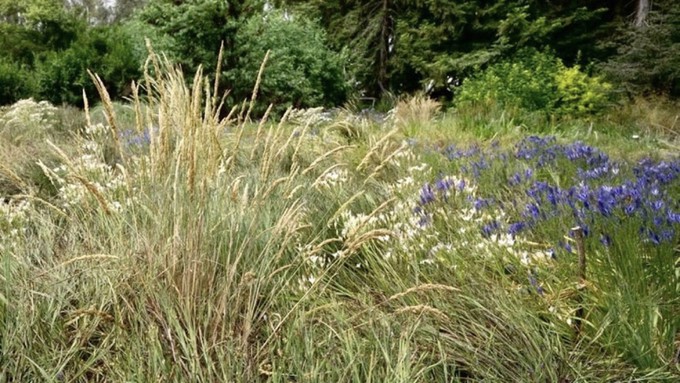
Event near Davis is free but requires registration

June grass, yarrow and Ithuriel's spear grow in the valley grassland area of Patricia Carpenter's property. Photo courtesy Beth Savidge
Many California natives rest or go dormant in the summer, so May is an excellent time to view native plants still in their spring flush.
This Sunday offers an ideal opportunity, as California Native Plant Society Ambassador Patricia Carpenter opens her garden west of Davis for her Late Spring Seasonal Native Garden Ramble.
Carpenter's 1-acre property, with more than 400 species and cultivars of natives, will be available for self-guided tours from 10 a.m. to 3 p.m. Sunday, May 21, starting at any time within those hours. The event is free but registration is required. The link to register can be found here. A map and plant list can be found on Carpenter's CNPS profile page.
In addition to viewing late-spring color, visitors will be able to see the many geophytes blooming in the garden. Seasonal maintenance, pruning, seed collecting, and plant propagation also will be in progress.
An optional short orientation and Q&A gathering with Carpenter will be held at 11 a.m. and again at 1 p.m. To participate, meet near the check-in table.
Visitors should bring a sun hat or personal umbrella and a filled water bottle. Toting a lunch or snack is allowed, but no dogs, please.
For more information, email both Patricia Carpenter <pcarpenter.flower@gmail.com> and Maya Argaman <margaman@cnps.org>.
Comments
0 comments have been posted.Sacramento Digs Gardening to your inbox.
Sites We Like
Garden Checklist for week of July 21
Your garden needs you!
* Keep your vegetable garden watered, mulched and weeded. Water before 8 a.m. to reduce the chance of fungal infection and to conserve moisture.
* Feed vegetable plants bone meal, rock phosphate or other fertilizers high in phosphate to stimulate more blooms and fruiting. (But wait until daily high temperatures drop out of the 100s.)
* Don’t let tomatoes wilt or dry out completely. Give tomatoes a deep watering two to three times a week.
* Harvest vegetables promptly to encourage plants to produce more. Squash especially tends to grow rapidly in hot weather. Keep an eye on zucchini.
* Pinch back chrysanthemums for bushy plants and more flowers in September.
* Remove spent flowers from roses, daylilies and other bloomers as they finish flowering.
* Pinch off blooms from basil so the plant will grow more leaves.
* Cut back lavender after flowering to promote a second bloom.
* It's not too late to add a splash of color. Plant petunias, snapdragons, zinnias and marigolds.
* From seed, plant corn, pumpkins, radishes, winter squash and sunflowers.